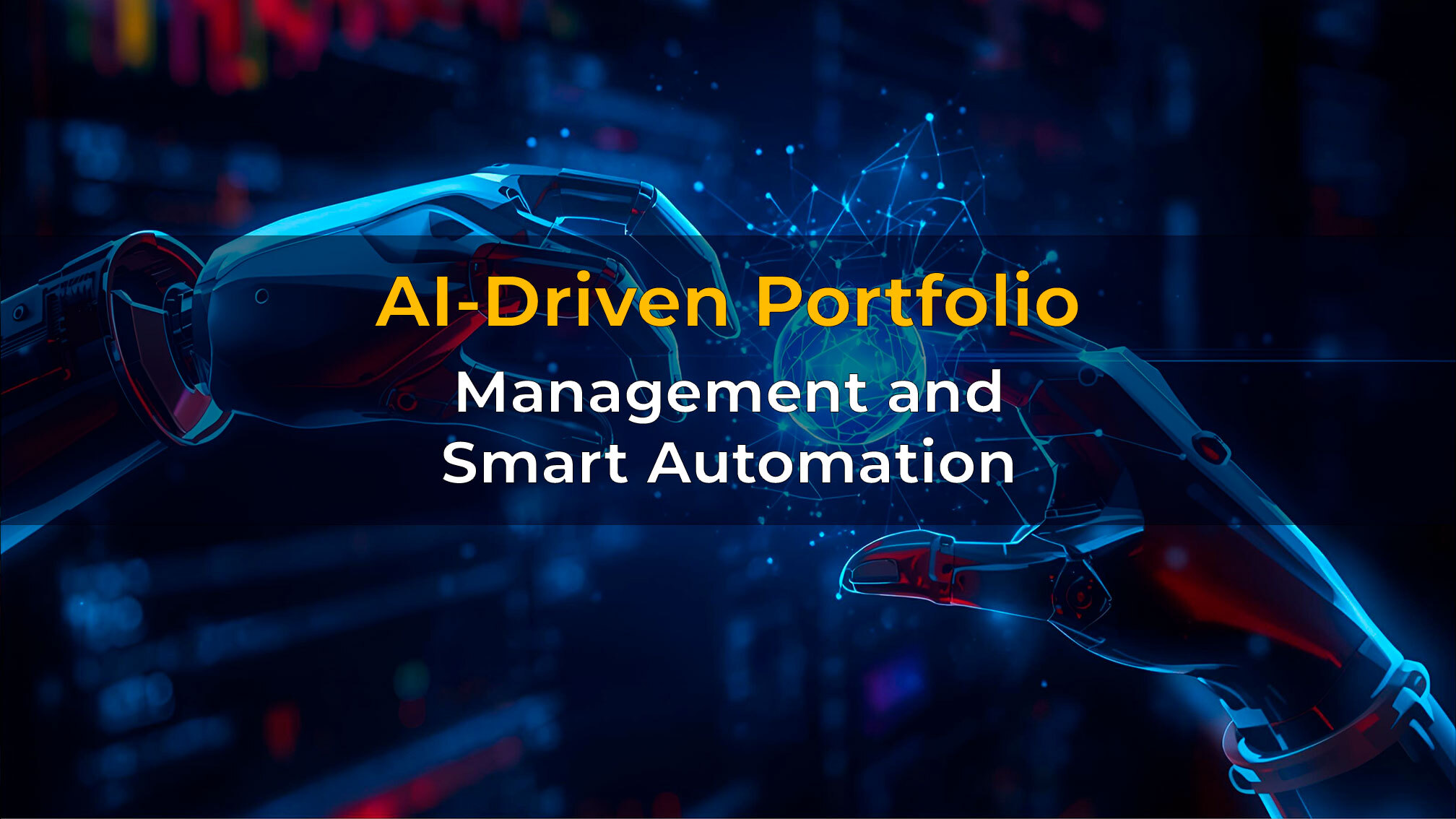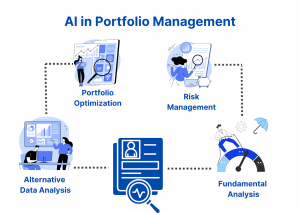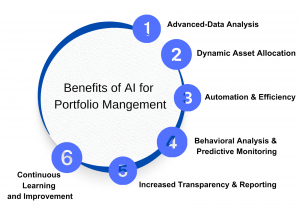
AI-Driven Portfolio Management and Smart Automation
18 сентября 2025
8 views
AI-Driven Portfolio Management and Smart Automation
The concept of portfolio management is undergoing its most significant evolution since the introduction of Modern Portfolio Theory. Today, the core decisions of asset allocation, risk sizing, and rebalancing are rapidly shifting from human intuition and manual processes to sophisticated, data-driven systems powered by Artificial Intelligence (AI).
This technological shift is ushering in the era of AI portfolio management, where models based on machine learning in trading can analyze global data sets, detect non-linear relationships, and execute trades autonomously in milliseconds. AI is not designed to replace the professional manager; rather, it serves as the ultimate cognitive and analytical co-pilot, augmenting human decision-making with unparalleled predictive analytics and adaptive power. Mastering this synergy is the defining trait of the next generation of financial leaders.
The Foundations of AI Portfolio Management
AI-driven portfolio management is a holistic system that leverages computational intelligence to construct, monitor, and adjust investment portfolios based on predefined objectives and dynamic market conditions.

Components and Core Synergy
The system operates across three interconnected stages:
- Data Ingestion: Collecting, cleaning, and aggregating massive, diverse data streams—from high-frequency market data to macroeconomic reports and alternative data (e.g., satellite imagery, sentiment).
- Algorithmic Decision-Making: Using machine learning in trading models to process this data, generate forecasts, and determine optimal portfolio weights and trade timing.
- Autonomous Execution: Employing smart trading tools and execution algorithms to implement the decisions with speed, minimal transaction cost, and maximum discretion.
The synergy between predictive analytics and automated investing offers clear benefits over traditional, static models: faster decision cycles that capture fleeting alpha opportunities, emotion-free rebalancing that adheres strictly to risk parameters, and scalable oversight of complex, multi-asset portfolios.
Predictive Analytics: Forecasting Market Movements Before They Happen
The primary value proposition of AI is its ability to extract actionable insights from data chaos through advanced predictive analytics. AI can identify signals that are invisible to human analysis or linear statistical methods.
ML Models for Forecasting
Machine learning in trading employs various models to forecast asset performance and market shifts:
- Regression Models (e.g., Elastic Net, Linear Regression): Used for forecasting continuous variables like future prices, volatility, or dividend yields.
- Tree-Based Models (e.g., Gradient Boosting Machines — GBMs): Excellent for handling complex, non-linear relationships and interactions between hundreds of variables (factors).
- Deep Neural Networks (e.g., LSTMs, Transformers): Utilized for modeling time-series data, detecting subtle regime shifts, and processing unstructured data like sentiment scores.
AI excels at factor prediction, identifying hidden relationships—for example, how the interaction between low liquidity, extreme social media sentiment, and rising corporate debt signals a high-probability sell-off in a specific sector. This enables the system to adapt to non-linear market behavior and detect early regime changes, offering a significant advantage over models that assume constant market parameters.
AI Portfolio Rebalancing and Optimization
Portfolio rebalancing in the AI era is no longer a periodic, calendar-based chore; it is a dynamic, continuous process driven by real-time risk, return, and cost considerations.
Continuous, Adaptive Optimization
AI systems leverage sophisticated optimization algorithms to maintain an ideal risk-return profile:
- Reinforcement Learning (RL): RL algorithms are trained to make sequential decisions (buy, sell, hold) with the explicit goal of maximizing a long-term utility function, such as the Sharpe ratio or Sortino ratio, rather than just maximizing immediate returns.
- Risk-Return Profiling: AI continuously monitors and refines the portfolio based on metrics like the Sortino ratio (focusing on downside risk) and expected drawdown, dynamically adjusting asset weights in response to volatility changes.
- Cost and Tax Efficiency: Smart execution algorithms integrate transaction costs, spread impacts, and tax implications (e.g., capital gains tax) directly into the optimization function. This ensures that the portfolio is not just theoretically optimal but also practically efficient, minimizing drag from trading friction.
Tools implementing these systems, often dubbed SmartT or smart allocation engines, perform automated rebalancing with pre-set risk constraints (maximum drawdown, target volatility) and adaptive triggers based on market signals, ensuring compliance and discipline.

Smart Automation Tools — The Brain and Hands of Modern Portfolios
The realization of AI portfolio management relies on smart trading tools that handle the complex execution and risk monitoring tasks.
Intelligent Automation Systems
These systems act as the bridge between the high-level strategy (the AI’s decision) and the low-level market action (the trade):
- Smart Allocation Engines: These proprietary systems automate position sizing, ensuring that new trades adhere to the portfolio’s desired risk optimization level. They might automatically hedge currency exposure or adjust beta exposure based on systemic risk indicators.
- Auto-Risk Allocation Systems: These are designed for volatility control. They dynamically shift capital between low-volatility assets (e.g., cash, bonds) and higher-volatility alpha sources (e.g., equities, commodities). For instance, when AI forecasts a period of market stress, the system automatically deleverages.
- AI Signal Integration: These tools seamlessly merge and prioritize signals from diverse sources—a sudden negative sentiment spike, a change in macroeconomic liquidity, or a technical breakdown—and translate them directly into a portfolio adjustment command.
Crucially, modern systems operate on a human-on-the-loop control structure. The machine executes and optimizes at superhuman speeds, but portfolio managers define the ethical boundaries, strategic constraints, and overall objective function.
Enhancing Diversification and Volatility Control with AI
AI’s analytical power allows portfolio managers to move beyond the limitations of classical mean-variance optimization (MVO) and achieve a deeper, more resilient form of automated diversification.
Advanced Diversification and Risk Control
- Dynamic Diversification: Traditional MVO relies on historical correlation, which often breaks down precisely when it is needed most (during a crisis). AI uses clustering algorithms to group assets based on latent, real-time risk factors rather than just price history. This allows for true automated diversification based on future correlation forecasts.
- Risk Parity Models: AI enhances risk parity by dynamically measuring the contribution of each asset to the overall portfolio risk budget, rebalancing not just based on weight, but on risk-contribution stability, ensuring smoother returns.
- Volatility Forecasting: AI leverages sophisticated models like Long Short-Term Memory (LSTM) networks—a type of deep learning model—to accurately forecast short-term and long-term volatility. By predicting volatility spikes before they materialize, the system can systematically reduce exposure, achieving powerful, anticipatory volatility control.
The ability to monitor and anticipate volatility clustering in real time allows systems to effectively reduce exposure before a major market shock, mitigating the impact on the portfolio’s maximum drawdown.
Case Study: AI-Augmented Multi-Asset Portfolios
Consider an AI portfolio management engine tasked with managing a global multi-asset portfolio encompassing equities, fixed income, tokenized commodities, and digital assets.
- Scenario: The system detects a significant spike in geopolitical risk sentiment (via NLP) and simultaneously forecasts a correlation shift between technology stocks and government bonds.
- AI Action: The system automatically reduces equity exposure, shifts capital from high-beta technology stocks into defensive healthcare assets, and increases its allocation to inflation hedges like tokenized commodities. It simultaneously uses crypto derivatives to hedge the system’s small digital assets exposure.
- Benefit: The result is a demonstrable improvement in the portfolio’s Sharpe ratio because the system successfully avoided a predicted market dip. The equity curve is significantly smoother, and the maximum drawdown is lower compared to a passively managed benchmark.
This seamless, cross-asset reallocation, driven by synthesized macro, technical, and sentiment signals, is beyond the capacity of even the most diligent human manager.
Ethical and Strategic Limits of Full Automation
While the capabilities of AI portfolio management are vast, professionals acknowledge that full autonomy is not always desirable nor strategically prudent.
Risks and Accountability
- Model Bias and Black-Box Opacity: If the training data is flawed or biased (e.g., underrepresenting certain market conditions), the resulting model will inherit those biases. Furthermore, the complexity of deep learning can lead to black-box opacity, where it is impossible to explain why a specific trade was generated, posing a serious problem for AI ethics in finance and regulatory compliance.
- Tail-Event Vulnerability: AI models are trained on historical data and often struggle with «Black Swan» events—unprecedented market shocks that fall outside the training set. This necessitates human oversight to apply contextual judgment during extreme crises.
- Human Accountability: Regulators increasingly demand explainability and accountability. The portfolio manager must remain the ultimate decision-maker, responsible for the logical constraints and ethical behavior of the smart trading tools.
The future is one of symbiosis, not substitution. Machines analyze and provide probabilities; humans interpret the «why» and set the ultimate strategic and ethical parameters.
The Human-AI Synergy in Portfolio Management
The new skill set for the modern portfolio manager centers on effective management of the intelligent system.
- Interpreting AI Output: The manager must move beyond basic financial analysis to understanding data science—interpreting AI’s predictive analytics output, challenging the model’s assumptions, and identifying potential overfitting.
- Oversight and Stress Testing: Professionals design oversight dashboards that track AI performance against established risk metrics in real-time. They use stress simulation and scenario testing to validate how the automated investing system reacts to conditions it has never encountered before.
- Applying Macro Judgment: The human role shifts from trade execution to macro-strategy design—determining which data streams the AI should prioritize, which assets are permissible, and what ethical red lines the system must adhere to.
The Future of Smart Automation — Autonomous Wealth Systems
The trajectory of AI portfolio management points toward increasingly sophisticated, autonomous, and transparent systems.
Emerging innovations will include:
- Self-Learning Portfolios: Systems using advanced reinforcement learning to continuously test new strategies and autonomously adapt their objective function based on evolving market efficiency.
- Decentralized Autonomous Funds (DAFs): Blockchain-based investment vehicles that use smart contracts for governance and AI trading systems for execution, offering fully transparent and auditable portfolio actions.
- Hybrid AI Architectures: Combining the pattern recognition power of deep learning with the logical transparency of symbolic AI to offer both high-performance and full explainability, mitigating black-box opacity.
In the next decade, AI will solidify its role, making sophisticated, adaptive, and highly optimized investment management accessible and standard across the entire wealth spectrum.
Conclusion — Managing Intelligence, Not Just Capital
AI-driven portfolio management transforms the static portfolio into an adaptive, intelligent ecosystem. By leveraging machine learning in trading for predictive analytics and smart trading tools for autonomous execution, professionals gain an essential edge in risk optimization and alpha capture. The winning strategy is not found in replacing human expertise, but in strategically aligning human judgment with the computational power of AI. In the age of smart automation, the portfolio manager’s highest purpose is to design the systems that learn, ensuring that capital is managed with discipline, intelligence, and an unparalleled level of adaptive control.




